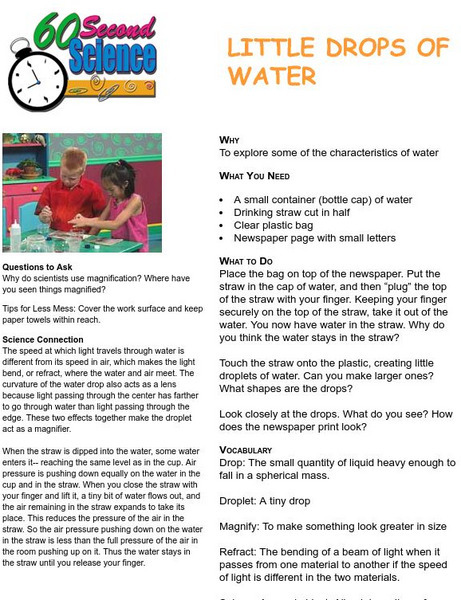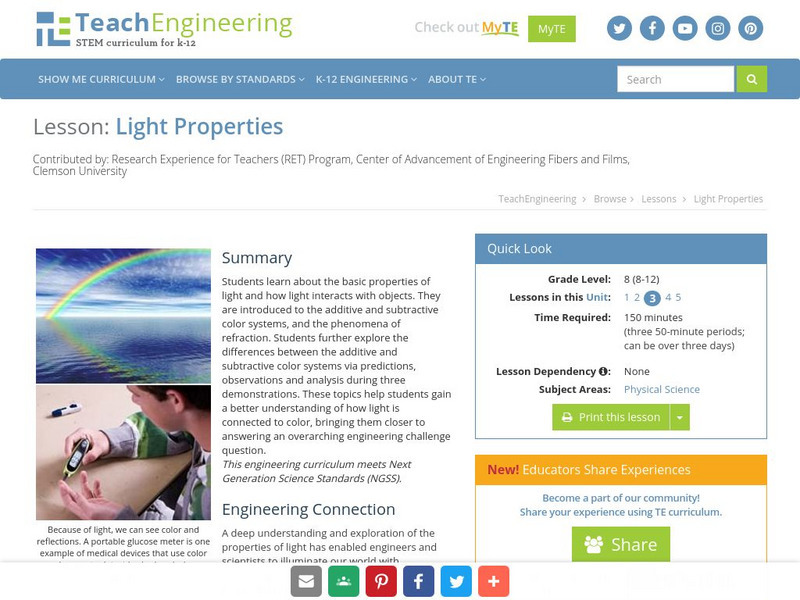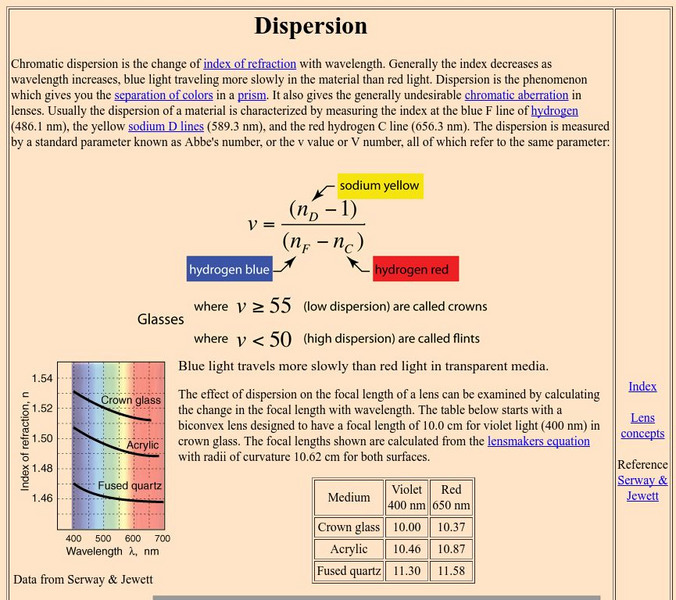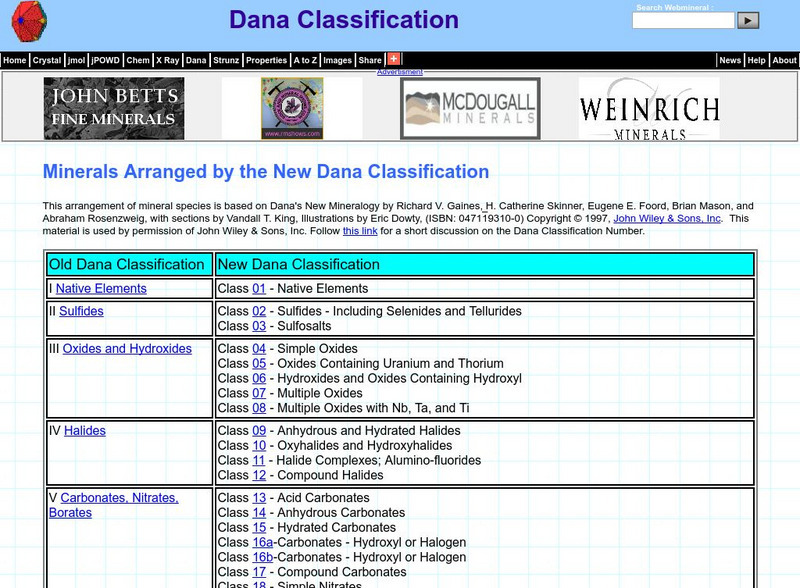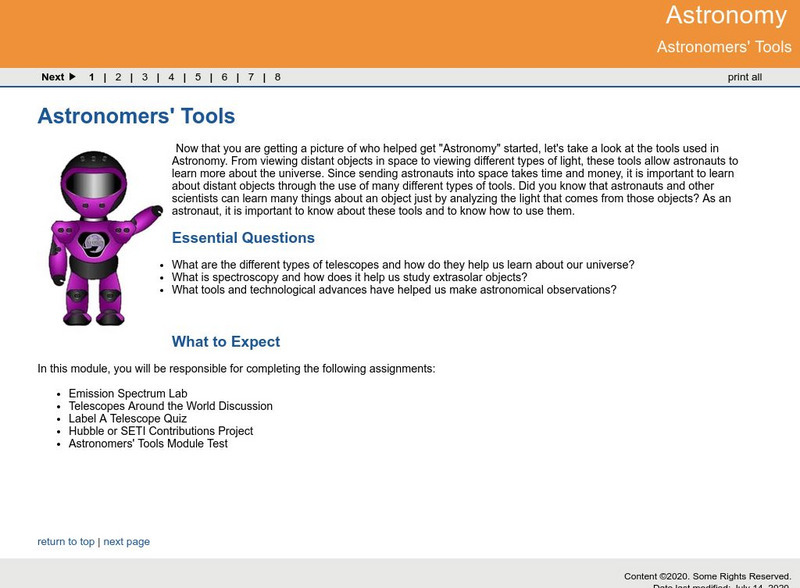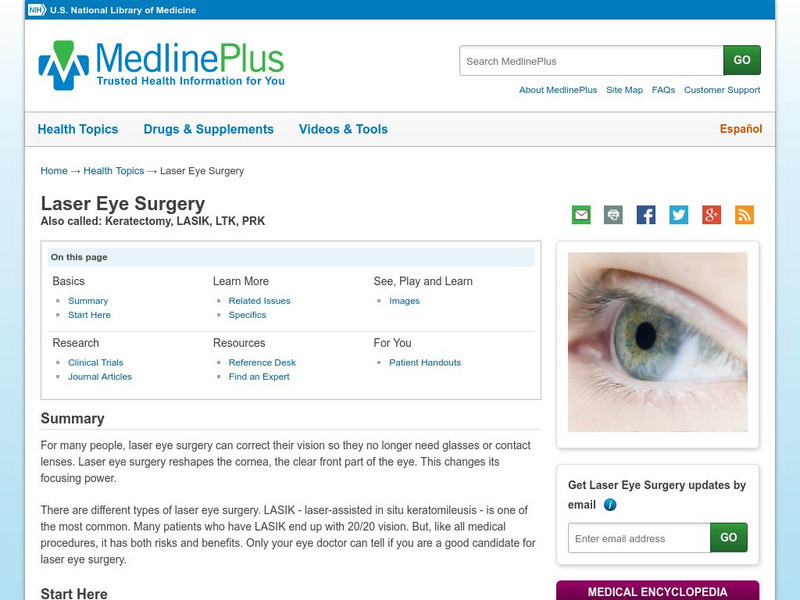ClassFlow
Class Flow: Introduction to Light
[Free Registration/Login Required] This flipchart introduces fifth graders to the science of light. Principles such as transparent, translucent, opaque, reflection, and refraction are covered. Concave and convex mirrors and lenses are...
Optical Society
Optical Society of America: Optics for Kids: Interference in a Ripple Tank
An investigation, using a ripple tank, into how waves behave when they collide with each other. With an explanation of what is observed, and a link to an article on refraction.
Mocomi & Anibrain Digital Technologies
Mocomi: What Is Scattering of Light?
Do you know why the sky is blue? Article defines scattering and how it works. Explains the difference between the scattering of light and reflection or refraction.
Khan Academy
Khan Academy: An Experiment With Light Rays and a Prism
This passage will test your knowledge on reflection and Refraction - Passage 2.
Wolfram Research
Wolfram Science World: Fresnel, Augustin
This site from ScienceWorld provides a short biographical sketch of Augustin Fresnel (1788-1827 CE) and describes his most notable scientific discoveries and contributions. Links are provided throughout for additional information.
University of St. Andrews (UK)
University of St. Andrews: Willebrord Snell
A fairly short biographical sketch of Willebrord Snell (1591-1626 CE). Discusses his upbringing, education and professional life.
Other
60 Second Science: Little Drops of Water Experiment
Explore the properties of water and observe how drops of water can act as a magnifying lens.
TeachEngineering
Teach Engineering: Energy
Through nine lessons, students are introduced to a range of energy types--electrical, light, sound and thermal-as well as the renewable energy sources of wind, hydro (water) and solar power. Subjects range from understanding that the...
TeachEngineering
Teach Engineering: Light Properties
Students learn about the basic properties of light and how light interacts with objects. They are introduced to the additive and subtractive color systems, and the phenomena of refraction. Students further explore the differences between...
TeachEngineering
Teach Engineering: Mind Bending Gps Occultations
Students learn about the remote sensing radio occultation technique and how engineers use it with GPS satellites to monitor and study the Earth's atmospheric activity. Students may be familiar with some everyday uses of GPS, but not as...
TeachEngineering
Teach Engineering: Tell Me Doc, Will I Get Cancer?
Students are introduced to the challenge called, Tell Me the Odds, discovering a new way to assess a person's risk of breast cancer. Solving this challenge requires knowledge of refraction and the properties of light.
Physics Classroom
The Physics Classroom: Lesson 3: Concave Mirrors
Lesson 3 of this tutorial on refraction is on concave mirrors. Content that is covered includes the anatomy of curved mirrors, reflection of light and image formation, ray diagrams, image characteristics for concave mirrors, plus more.
Physics Classroom
The Physics Classroom: Polarization
"How Do We Know Light Behaves as a Wave?" An answer is provided in this discussion of the polarization of light and the use of Polaroid filters in sunglasses. The four methods discussed on this page are: polarization by transmission,...
CK-12 Foundation
Ck 12: Concave and Convex Lenses
[Free Registration/Login may be required to access all resource tools.] Students describe and predict image formation as a consequence of refraction through a thin convex lens.
Physics Classroom
The Physics Classroom: Image Formation by Lenses
This lesson explains what lenses are, the different between a converging and diverging lens, the difference between a double convex and double concave lens, and gives definitions for terms related to lenses.
Georgia State University
Georgia State University: Hyper Physics: Thin Lens Equation
This is an informative site from Georgia State University. It gives a discussion of the thin lens equation and an illustration of its use in determining the image distance based upon the object distance and the focal length.
Georgia State University
Georgia State University: Hyper Physics: Dispersion
The phenomenon of light dispersion is explained with a formula and a practice form for calculating Abbe's number.
Science Buddies
Science Buddies: Project Ideas: Bitter to Sweet: Sugar Changes in Ripening Fruit
In this science fair project, use a refractometer to measure changes in sugar content in ripening fruit. The Science Buddies project ideas are set up consistently beginning with an abstract, objective, and introduction, followed by a...
Science Buddies
Science Buddies: Using a Laser to Measure the Speed of Light in Jello
Think it takes expensive, sophisticated equipment to measure the speed of light? Think again. Outfit yourself with a simple handheld laser pointer, a protractor, and Jell-O, and you're ready to get started.
Other
New Dana System Mineralogy Database
Over 3,900 mineral species descriptions are included in this HTML-linked table of Dana classifications for all known valid mineral species. 3-D models are available for over 600 minerals.
Other
Meade Instruments Corporation: How Telescopes Work
This page explains in fairly simple terms the basics of telescopes. It includes information on the various types of telescopes and the factors people use to select the correct telescope for them. Meade is a leading telescope manufacturer.
Georgia Department of Education
Ga Virtual Learning: Astronomers' Tools
In this interactive tutorial students will learn about a few of the instruments used to further our knowledge of the Universe around us.
US National Library of Medicine
Medline Plus: Laser Eye Surgery
Information is provided about laser surgery, which is used to correct vision problems and eliminate the need for glasses or contacts.
Other
Transverse and Longitudinal Wave Propagation in an Elastic Medium
Extensive information about how waves behave in an elastic medium. Covers different types of waves, their characteristics and behavior, the anatomy of the ear, the speed of sound in different media, the parts of a wave, and wave phenomena.
Other popular searches
- Light Refraction
- Reflection and Refraction
- Light Reflection Refraction
- Refraction of Light
- Index of Refraction
- Reflection Refraction
- Science Light Refraction
- Absolute Index of Refraction
- Wave Reflection Refraction
- Diffraction and Refraction
- Light Refraction Water
- Angle of Refraction






